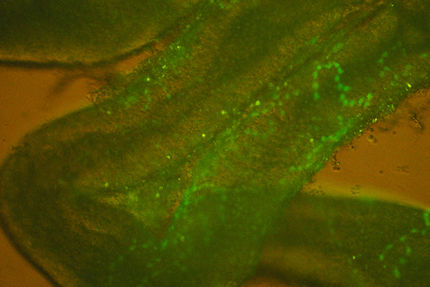Stem cells repair damaged spinal cord tissue
Researchers at the Swedish medical university Karolinska Institutet have shown how stem cells, together with other cells, repair damaged tissue in the mouse spinal cord. The results are of potential significance to the development of therapies for spinal cord injury.
There is hope that damage to the spinal cord and brain will one day be treatable using stem cells (i.e. immature cells that can develop into different cell types). Stem cell-like cells have been found in most parts of the adult human nervous system, although it is still unclear how much they contribute to the formation of new, functioning cells in adult individuals.
A joint study by Professor Jonas Frisén’s research group at Karolinska Institutet and their colleagues from France and Japan, and published in Cell Stem Cell, shows how stem cells and several other cell types contribute to the formation of new spinal cord cells in mice and how this changes dramatically after trauma.
The research group has identified a type of stem cell, called an ependymal cell, in the spinal cord. They show that these cells are inactive in the healthy spinal cord, and that the cell formation that takes place does so mainly through the division of more mature cells. When the spinal cord is injured, however, these stem cells are activated to become the dominant source of new cells.
The stem cells then give rise to cells that form scar tissue and to a type of support cell that is an important component of spinal cord functionality. The scientists also show that a certain family of mature cells known as astrocytes produce large numbers of scar-forming cells after injury.
“The stem cells have a certain positive effect following injury, but not enough for spinal cord functionality to be restored,” says Jonas Frisén. “One interesting question now is whether pharmaceutical compounds can be identified to stimulate the cells to form more support cells in order to improve functional recovery after a spinal trauma.”
Original publication: Fanie Barnabé-Heider, Christian Göritz, Hanna Sabelström, Hirohide Takebayashi, Frank W. Pfrieger, Konstantinos Meletis & Jonas Frisén; “Origin of new glial cells in the intact and injured adult spinal cord”; Cell Stem Cell 2010.
Most read news
Other news from the department science

Get the life science industry in your inbox
By submitting this form you agree that LUMITOS AG will send you the newsletter(s) selected above by email. Your data will not be passed on to third parties. Your data will be stored and processed in accordance with our data protection regulations. LUMITOS may contact you by email for the purpose of advertising or market and opinion surveys. You can revoke your consent at any time without giving reasons to LUMITOS AG, Ernst-Augustin-Str. 2, 12489 Berlin, Germany or by e-mail at revoke@lumitos.com with effect for the future. In addition, each email contains a link to unsubscribe from the corresponding newsletter.





















































